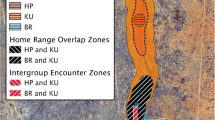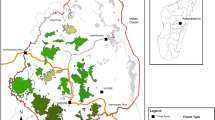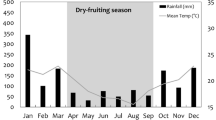Abstract
Successful conservation requires an understanding of animal movement patterns and space use. Such data are hard to obtain, however, when difficult terrain, nocturnal habits, or lack of habituation make direct observation impractical. White-footed tamarins (Saguinus leucopus) are small primates endemic to Colombia that are in danger of extinction due to habitat loss, fragmentation, and the illegal pet trade. Here, we report the results of the first study to use radio-tracking to investigate white-footed tamarin ranging behavior. We recorded the movements of three neighboring tamarin groups simultaneously for 3 month using radio-telemetry. Home range sizes (estimated using both minimum convex polygon and fixed kernel contour methods) were substantially larger than reported in previous studies that did not use remote-tracking. Monte Carlo resampling procedures revealed that home range size differed significantly among the three groups but that the mean daily path length did not. As in other tamarin species, the degree of range overlap between neighboring social groups was high, ranging from 27 to 81%. Using a randomization test, we showed that the observed mean distance between groups was significantly lower than expected by chance for two of the three group dyads. This pattern of intergroup “attraction,” in conjunction with substantial range overlap and high population density, implies that the Bellavista Forest, one of the few remaining habitats of Saguinus leucopus, may be saturated, and promoting habitat restoration should be a priority for the conservation of this species.


Similar content being viewed by others
References
Buchanan-Smith, H. (1991). A field study on the red-bellied tamarin, Saguinus l. labiatus, in Bolivia. International Journal of Primatology, 12(3), 259–276.
Calenge, C. (2006). The package “adehabitat” for the R software: a tool for the analysis of space and habitat use by animals. Ecological Modelling, 197(3–4), 516–519.
Cords, M. (2002). Friendship among adult female blue monkeys (Cercopithecus mitis). Behaviour, 139(2–3), 291–314.
Cords, M. (2007). Variable participation in the defense of communal feeding territories by blue monkeys in the Kakamega Forest, Kenya. Behaviour, 144, 1537–1550.
Dawson, G. A. (1979). The use of time and space by the Panamanian tamarin Saguinus oedipus. Folia Primatologica, 31, 253–284.
Defler, T. (2010). Historia natural de los primates colombianos (2nd ed.). Bogotá: Universidad Nacional de Colombia. Facultad de Ciencias. Departamento de Biología.
Defler, T. R. (2004). Primates of Colombia. Bogotá: Conservación Internacional.
Doncaster, C. P. (1990). Non-parametric estimates of interaction from radio-tracking data. Journal of Theoretical Biology, 143(4), 431–443.
Fuentes, J. A., Zerda-Ordóñez, E., & Muñoz-Durán, J. (2013). Vocal communication of white-footed tamarin (Saguinus leucopus) in the wild. Caldasia, 35(1), 49–63.
Garber, P. A. (1988). Diet, foraging patterns, and resource defense in a mixed species troop of Saguinus mystax and Saguinus fuscicollis in Amazonian Peru. Behaviour, 105(1–2), 18–34.
Garber, P. A. (1993). Feeding, ecology, and behaviour of the genus Saguinus. In A. Rylands (Ed.), Marmosets and tamarins: Systematics, behaviour, and ecology (pp. 273–295). Oxford: Oxford University Press.
Garber, P. A. (1998). One for all and breeding for one: cooperation and competition as a tamarin reproductive strategy. Evolutionary Anthropology, 5(6), 187–199.
Garber, P. A., Encarnacion, F., Moya, L., & Pruetz, J. D. (1993). Demographic and reproductive patterns in moustached tamarin monkeys (Saguinus mystax)—implications for reconstructing platyrrhine mating systems. American Journal of Primatology, 29(4), 235–254.
Heymann, E. W. (2000). Spatial patterns of scent marking in wild moustached tamarins, Saguinus mystax: no evidence for a territorial function. Animal Behaviour, 60(6), 723–730.
IUCN (2011). IUCN red list of threatened species. Version 2011.2. (Accessed August 6, 2011).
Kernohan, B. J., Gitzen, R. A., & Millspaugh, J. J. (2001). Analysis of animal space use and movements. In J. J. Millspaugh & J. M. Marzluff (Eds.), Radio tracking and animal populations (pp. 125–166). San Diego: Academic.
Kie, J. G., Matthiopoulos, J., Fieberg, J., Powell, R. A., Cagnacci, F., Mitchell, M. S., et al. (2010). The home-range concept: are traditional estimators still relevant with modern telemetry technology? Philosophical Transactions of the Royal Society of London. Series B, Biological Sciences, 365(1550), 2221–2231.
Lazaro-Perea, C. (2001). Intergroup interactions in wild common marmosets, Callithrix jacchus: territorial defence and assessment of neighbours. Animal Behaviour, 62, 11–21.
Lowen, C., & Dunbar, R. I. M. (1994). Territory size and defendability in primates. Behavioral Ecology and Sociobiology, 35(5), 347–354.
Mendes Pontes, A., & Monteiro da Cruz, M. (1995). Home range, intergroup transfers, and reproductive status of common marmosets Callithrix jacchus in a forest fragment in North-Eastern Brazil. Primates, 36(3), 335–347.
Minta, S. (1992). Tests of spatial and temporal interaction among animals. Ecological Applications, 2(2), 178–188.
Mitani, J. C., & Rodman, P. S. (1979). Territoriality: the relation of ranging pattern and home range size to defendability, with an analysis of territoriality among primate species. Behavioral Ecology and Sociobiology, 5, 241–251.
Mohr, C. O. (1947). Table of equivalent populations of north American small mammals. American Midland Naturalist, 37(1), 223–249.
Morales, J. M., Moorcroft, P. R., Matthiopoulos, J., Frair, J. L., Kie, J. G., Powell, R. A., et al. (2010). Building the bridge between animal movement and population dynamics. Philosophical Transactions of the Royal Society of London. Series B, Biological Sciences, 365(1550), 2289–2301.
Morales-Jiménez, A., Vejarano, S., Rodríguez, C., Ospina, O. (2008). Programa Nacional para la Conservación de la Especie Endémica de Colombia Tití Gris (Saguinus leucopus), Bogotá.
Müller, K., & Schildger, J. (1994). Capture and radio-telemetry of masked titi monkeys, Callicebus personatus melanochir. Neotropical Primates, 2(4), 7–8.
Nams, V. O. (2006). Locate III user’s guide. Tatamagouche: Pacer Computer Software.
Nunn, C. L., & Dokey, A. T. (2006). Ranging patterns and parasitism in primates. Biology Letters, 2, 351–354.
Peres, C. A. (2000). Territorial defense and the ecology of group movements in small-bodied neotropical primates. In S. Boinski & P. Garber (Eds.), On the move: How and why animals travel in groups (pp. 100–123). Chicago: University of Chicago Press.
Poveda, K., & Sánchez-Palomino, P. (2004). Habitat use by the white-footed tamarin, Saguinus leucopus: a comparison between a forest-dwelling group and an urban group in Mariquita, Colombia. Neotropical Primates, 12(1), 6–9.
R Development Core Team. (2011). R: A language and environment for statistical computing. Vienna: R foundation for Statistical Computing.
Raboy, B. E., Canale, G. R., & Dietz, J. M. (2008). Ecology of Callithrix kuhlii and a review of eastern Brazilian marmosets. International Journal of Primatology, 29(2), 449–467.
Revilla, E., & Wiegand, T. (2008). Individual movement behavior, matrix heterogeneity, and the dynamics of spatially structured populations. Proceedings of the National Academy of Sciences of the United States of America, 105(49), 19120–19125.
Roncancio, N. J., Rojas, W., & Defler, T. (2011). Densidad poblacional de Saguinus leucopus en remanentes de bosque con diferentes características físicas y biológicas. Mastozoología Neotropical, 18, 105–117.
Rueda, L. E., & Zerda, E. (2009). Comunicación Vocal de un Grupo de Tití Gris (Saguinus leucopus) en Mariquita, Colombia. Neotropical Primates, 16(1), 37–43.
Sánchez-Londoño, J., Arias, A., Barragán, K., & Montoya, M. (2009). Evaluación del estado de la población del tití gris, Saguinus leucopus, en el área de influencia del proyecto trasvase Guarinó y propuesta de estrategias para su conservación. Final report. Colombia: Asociación de Veterinarios de Vida Silvestre, Colombia.
Savage, A., Giraldo, L. H., Blumer, E. S., Soto, L. H., Burger, W., & Snowdon, C. T. (1993). Field techniques for monitoring cotton-top tamarins (Saguinus oedipus oedipus) in Colombia. American Journal of Primatology, 31(3), 189–196.
Seaman, D. E., Millspaugh, J. J., Kernohan, B. J., Brundige, G. C., Raedeke, K. J., & Gitzen, R. A. (1999). Effects of sample size on kernel home range estimates. Journal of Wildlife Management, 63(2), 739–747.
Stevenson, P. R., Guzman, D. C., & Defler, T. R. (2010). Conservation of Colombian primates: an analysis of published research. Tropical Conservation Science, 3(1), 45–62.
Sussman, R. W. (2003). Primate ecology and social structure, vol. 2: New World Monkeys (revised first edition). Boston: Pearson Custom Publishing.
Waser, P. M. (1976). Cercocebus albigena—site attachment, avoidance, and intergroup spacing. American Naturalist, 110(976), 911–935.
Wauters, L. A., Lens, L., & Dhondt, A. A. (1995). Variation in territory fidelity and territory shifts among red squirrel, Sciurus vulgaris, females. Animal Behaviour, 49(1), 187–193.
White, G. C., & Garrott, R. A. (1990). Analysis of wildlife radio-tracking data. San Diego: Academic.
Wich, S. A., & Nunn, C. L. (2002). Do male ‘loud calls’ function in mate defense? A comparative study of long-distance calls in primates. Behavioral Ecology and Sociobiology, 52, 474–484.
Worton, B. J. (1989). Kernel methods for estimating the utilization distribution in home range studies. Ecology, 70(1), 164–168.
Acknowledgments
We thank the regional environmental government authority CORPOCALDAS (Corporacion Autónoma Regional de Caldas) for permission to conduct this research and for financial support. We also thank Luis Soto (Proyecto Titi Foundation) for training in the capture and radio collaring of tamarins, and Asociación de Veterinarios de Vida Silvestre and the staff from Centro de Rehabilitacion de Fauna Silvestre del Oriente de Caldas (CRFSOC) for technical support. We thank Andrés, Efraín, Amilvia, Jose, Willy, and the family Carvajal Betancur for their support during the field work. We thank Oscar Ospina, Nestor Roncancio, Adriana Bilgray, and Oris Acevedo for logistical support; Vanessa Perez, Jesualdo Fuentes, and Egbert Leigh for helpful suggestions; and Ryan Chisolm for statistical advice. We also thank the anonymous reviewers whose comments have improved this manuscript. Funding for this project was provided by the Margot Marsh Foundation, the Wildlife Conservation Society, Fundación Biodiversa Colombia, Colciencias (Programa Jóvenes Investigadores e Innovadores “Virginia Gutierrez de Pineda”), Grupo en Conservación y Manejo de Vida Silvestre (Universidad Nacional de Colombia), the Smithsonian Tropical Research Institute, and the Max Planck Institute for Ornithology. D. Caillaud was supported by NSF grant DEB-0749097 to L. A. Meyers.
Author information
Authors and Affiliations
Corresponding author
Rights and permissions
About this article
Cite this article
Alba-Mejia, L., Caillaud, D., Montenegro, O.L. et al. Spatiotemporal Interactions Among Three Neighboring Groups of Free-Ranging White-Footed Tamarins (Saguinus leucopus) in Colombia. Int J Primatol 34, 1281–1297 (2013). https://doi.org/10.1007/s10764-013-9740-6
Received:
Accepted:
Published:
Issue Date:
DOI: https://doi.org/10.1007/s10764-013-9740-6




